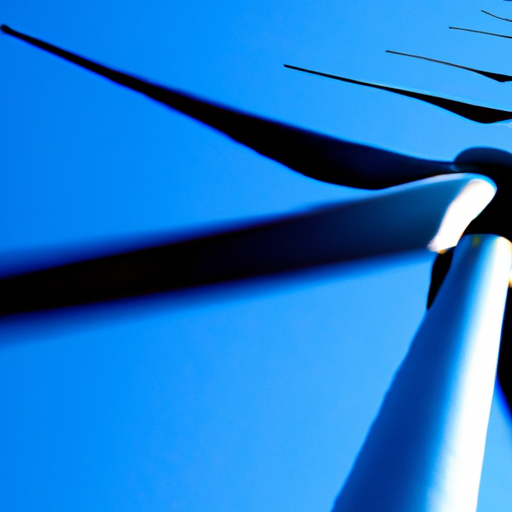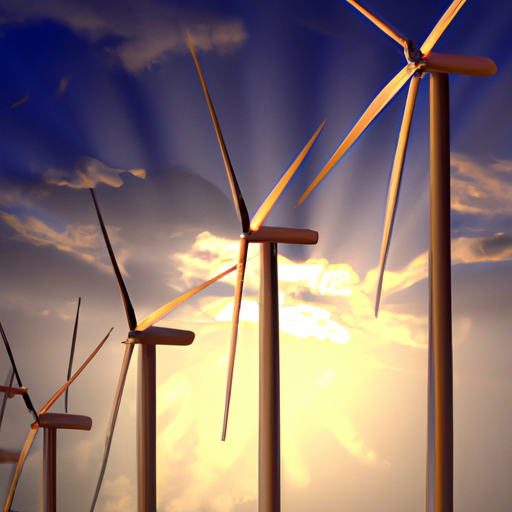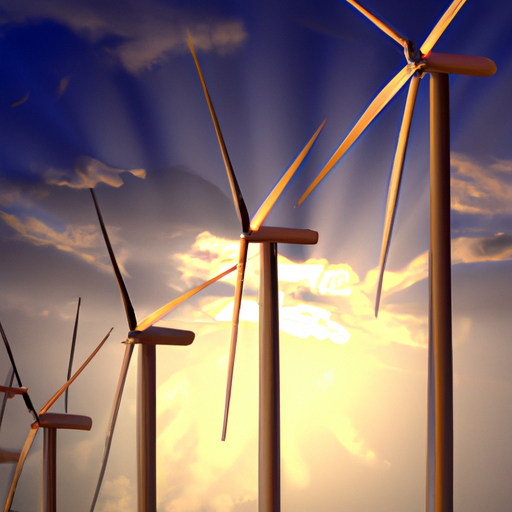Energy Industry Trends
In this article, you will explore the latest energy industry trends that are shaping the future of our planet. From advancements in renewable energy to the impact of technology on conventional energy sources, these trends are revolutionizing the way we produce and consume power. Join us as we dive into the exciting world of the energy industry, uncovering the key developments and innovations that are driving sustainable change and paving the way for a greener tomorrow.

Table of Contents
1. Renewable Energy
Renewable energy is a rapidly growing sector in the energy industry, driven by the need to reduce greenhouse gas emissions and mitigate climate change. There are several types of renewable energy sources that are being tapped into, each with its own unique advantages and challenges.
1.1 Solar Power
Solar power is one of the most popular forms of renewable energy. It harnesses the energy from the sun and converts it into electricity using photovoltaic (PV) panels. Solar power is abundant, sustainable, and can be used in various settings, ranging from residential rooftops to large-scale solar farms. Additionally, the cost of solar panels has significantly decreased over the years, making it more accessible to consumers.
1.2 Wind Energy
Wind energy is another prominent source of renewable energy. It utilizes wind turbines to convert the kinetic energy of the wind into electricity. Wind turbines can be installed on land or offshore, and they generate electricity without producing any greenhouse gas emissions. Wind power is highly scalable, and as the technology advances, the efficiency and capacity of wind turbines continue to improve.
1.3 Hydroelectric Power
Hydroelectric power is generated by harnessing the energy of flowing or falling water. It is a mature and well-established form of renewable energy, with large hydroelectric dams being used to generate significant amounts of electricity. Hydroelectric power offers a reliable and consistent source of energy, but its development may require significant infrastructure and can have environmental impacts, such as altering river ecosystems.
1.4 Geothermal Energy
Geothermal energy taps into the heat stored within the Earth’s crust and converts it into electricity. This form of renewable energy is particularly suitable in geologically active regions where hot water or steam can be extracted from beneath the ground. Geothermal power plants emit minimal greenhouse gas emissions and provide a constant and reliable source of energy, making them highly attractive for baseload power generation.
1.5 Biomass Energy
Biomass energy utilizes organic matter, such as plant material and agricultural waste, to generate heat and electricity. Biomass can be burned directly or converted into biogas or biofuels. The advantage of biomass energy is that it can utilize waste streams and agricultural by-products, reducing landfill waste and providing a renewable energy source. However, the sustainability of biomass energy depends on responsible sourcing and the prevention of deforestation.
2. Energy Storage
As renewable energy becomes more prevalent, the importance of energy storage technologies is growing. Energy storage plays a crucial role in balancing supply and demand, ensuring a steady and reliable energy supply even when renewable sources are intermittent.
2.1 Batteries
Batteries are one of the most widely recognized energy storage technologies. They store electrical energy in chemical form and can be discharged when needed. Batteries have significant applications in portable electronics, electric vehicles, and grid-scale energy storage. Advances in battery technology, such as lithium-ion batteries, have improved their efficiency, energy density, and lifespan, making them an integral part of the energy transition.
2.2 Pumped Hydro Storage
Pumped hydro storage is a well-established method of energy storage that utilizes the potential energy of water stored in an upper reservoir. During periods of excess electricity generation, water is pumped uphill to the reservoir. When electricity demand exceeds supply, the water is released back downhill, turning turbines and generating electricity. Pumped hydro storage systems are highly efficient but have limitations on suitable locations due to geographical requirements.
2.3 Compressed Air Energy Storage
Compressed air energy storage (CAES) is a technology that stores energy in the form of compressed air. Excess electricity is used to compress air and then stored in underground caverns or pressurized containers. When electricity demand is high, the compressed air is released and expanded through turbines to generate electricity. CAES systems can provide large-scale energy storage capacity with relatively low operating costs and long-term storage capabilities.
2.4 Flywheel Energy Storage
Flywheel energy storage systems use a spinning rotor to store and release energy. Excess electricity is used to accelerate the rotor to high speeds, storing the energy as rotational kinetic energy. When electricity demand exceeds supply, the flywheel releases the stored energy by decelerating. Flywheel energy storage offers high power density and rapid response times, making it suitable for short-duration energy storage and grid stabilization.
2.5 Thermal Energy Storage
Thermal energy storage refers to the storage of heat or cold for later use. This technology is particularly useful in applications such as district heating and cooling, solar thermal power plants, and industrial processes. Thermal energy can be stored in various forms, including hot water, molten salts, and phase change materials. Thermal energy storage enables the utilization of excess heat or cold and improves energy efficiency, reducing the reliance on fossil fuels.

3. Energy Efficiency
Energy efficiency measures aim to reduce energy consumption while maintaining or improving the desired functionality. Improving energy efficiency is a cost-effective approach to meeting energy demands while reducing greenhouse gas emissions.
3.1 Smart Grid Technology
Smart grid technology integrates advanced communication and information technologies into the electricity grid infrastructure, enabling two-way communication between consumers, utilities, and distributed energy resources. This technology optimizes energy distribution, improves grid reliability, and allows for better integration of renewable energy sources. Smart grids also enable demand response programs that encourage consumers to shift their energy consumption to off-peak hours, reducing the strain on the grid during peak demand periods.
3.2 Energy Management Systems
Energy management systems provide tools and strategies for monitoring and optimizing energy use in buildings, industries, and other facilities. These systems enable real-time monitoring, data analysis, and control of energy-consuming devices and processes. Energy management systems can identify areas of inefficiency, provide insights for energy conservation measures, and help track and manage energy consumption, leading to substantial energy savings and cost reductions.
3.3 Building Energy Efficiency
Building energy efficiency focuses on improving the energy performance of new and existing buildings. Measures include insulation, weather sealing, efficient HVAC systems, and advanced lighting technologies. Building energy codes and standards play a critical role in promoting energy-efficient construction practices. Energy-efficient buildings can significantly reduce energy consumption, lower operating costs, improve occupant comfort, and contribute to greenhouse gas emission reductions.
3.4 Industrial Energy Efficiency
Industrial energy efficiency aims to reduce energy consumption in manufacturing processes, optimizing system performance and minimizing energy losses. Advanced technologies, such as combined heat and power (CHP) systems, heat recovery systems, and process optimization, can significantly improve energy efficiency in industries. Energy management practices, employee training, and energy audits play a crucial role in identifying energy-saving opportunities and implementing effective energy efficiency measures.
3.5 Energy-Efficient Appliances
Energy-efficient appliances, such as refrigerators, air conditioners, washing machines, and lighting, are designed to use less energy without sacrificing performance. These appliances often carry energy labels that provide consumers with information on energy efficiency and help make informed purchasing decisions. The increased adoption of energy-efficient appliances can result in significant energy savings and contribute to reducing carbon emissions on a global scale.
4. Electric Vehicles
Electric vehicles (EVs) have gained traction as a viable alternative to conventional vehicles, contributing to transportation electrification and reducing reliance on fossil fuels.
4.1 Electric Vehicle Adoption
The adoption of electric vehicles has been increasing rapidly, driven by advancements in battery technology, government incentives, and growing environmental awareness. Electric vehicles produce zero tailpipe emissions, reducing air pollution and greenhouse gas emissions. The expansion of public charging infrastructure, increased vehicle range, and declining costs are making EVs more accessible and appealing to consumers, paving the way for a widespread transition to electric transportation.
4.2 Charging Infrastructure
A robust charging infrastructure is essential to support the growing adoption of electric vehicles. Public and private charging stations play a critical role by providing convenient and accessible charging options for EV owners. The expansion of fast-charging networks, the installation of charging stations in residential areas and workplaces, and the integration of charging infrastructure with renewable energy sources are key factors in promoting electric vehicle adoption and ensuring a reliable and efficient charging experience.
4.3 Battery Technology
Battery technology is at the core of electric vehicle development. Advances in battery chemistry, energy density, and charging speed are enabling longer-range electric vehicles with faster charging capabilities. Lithium-ion batteries are currently the dominant technology in electric vehicles, but research and development efforts are focused on improving performance, reducing costs, and exploring alternative battery chemistries, such as solid-state batteries, to further enhance the viability of electric transportation.
4.4 Vehicle-to-Grid Integration
Vehicle-to-grid (V2G) integration refers to the bi-directional flow of electricity between electric vehicles and the power grid. Electric vehicles can act as mobile energy storage devices, allowing surplus energy from the grid to be stored in their batteries and later transferred back to the grid during peak demand periods. V2G integration has the potential to enhance grid stability, support renewable energy integration, and provide economic benefits to EV owners through energy arbitrage, effectively turning electric vehicles into a distributed energy resource.
4.5 Autonomous Electric Vehicles
The convergence of electric vehicle technology and autonomous driving capabilities is set to revolutionize the transportation industry. Autonomous electric vehicles (AEVs) have the potential to improve road safety, reduce traffic congestion, and further enhance the environmental benefits of electric transportation. AEVs can be integrated into ride-sharing and transportation-as-a-service models, which could lead to a significant reduction in the overall number of vehicles on the road and optimize energy consumption.

5. Energy Transition in Developing Countries
The energy transition is not limited to developed nations. Developing countries are also striving to transition to cleaner and more sustainable energy systems to meet their growing energy demands while addressing the challenges of energy poverty and environmental degradation.
5.1 Access to Clean Energy
Access to clean energy is a challenge for many developing countries. Expanding energy access through the deployment of renewable energy technologies and decentralized energy solutions can help bridge the energy gap and improve the quality of life for millions of people. Off-grid solar systems, mini-grids, and community-based renewable energy projects play a crucial role in providing clean and reliable electricity to remote areas where grid connection is either unfeasible or economically inaccessible.
5.2 Decentralized Energy Systems
Decentralized energy systems empower communities to produce, distribute, and consume energy locally. This approach reduces transmission losses, improves energy resilience, and fosters local economic development. Small-scale renewable energy projects, such as solar home systems and mini-hydro plants, can be integrated into decentralized energy systems, enabling communities to meet their energy needs sustainably and autonomously.
5.3 Mini-Grid Solutions
Mini-grids are localized electricity generation and distribution systems that serve a small community or a cluster of customers. These systems are particularly well-suited for areas with limited grid access. Mini-grids powered by renewable energy sources, such as solar and wind, offer sustainable electricity supply and can support productive uses, such as powering agricultural machinery, schools, and healthcare facilities, contributing to socio-economic development in rural areas.
5.4 Energy Poverty Reduction
Energy poverty is a significant challenge in developing countries, where a large portion of the population lacks access to reliable and affordable energy services. Efforts to reduce energy poverty involve deploying clean and sustainable energy technologies, improving energy infrastructure, and facilitating financial mechanisms for energy access. Microfinance initiatives and innovative business models, such as pay-as-you-go systems, can enable low-income households to afford clean energy solutions and break the cycle of energy poverty.
5.5 Sustainable Rural Electrification
Sustainable rural electrification programs aim to provide clean and reliable electricity to rural communities, supporting their development and improving living standards. These programs prioritize the use of renewable energy sources, such as solar, wind, and biomass, to reduce dependence on fossil fuels and minimize environmental impacts. Effective project planning, community engagement, and capacity building are crucial for the successful implementation of sustainable rural electrification initiatives.
6. Carbon Capture and Storage
Carbon capture and storage (CCS) technologies are designed to capture carbon dioxide emissions from power plants and industrial facilities, preventing them from entering the atmosphere and mitigating climate change.
6.1 Carbon Capture Technology
Carbon capture technology involves capturing carbon dioxide emissions before they are released into the atmosphere. Various methods, such as post-combustion capture, pre-combustion capture, and oxyfuel combustion, can be employed depending on the type of emission source. Carbon capture technologies are being developed and deployed to reduce carbon emissions from fossil fuel-based power generation and industrial processes.
6.2 Carbon Storage Methods
Captured carbon dioxide can be permanently stored underground in geological formations, such as depleted oil and gas reservoirs or deep saline aquifers. This process is known as carbon storage or carbon sequestration. The stability and capacity of these storage sites must be carefully evaluated to ensure the safe and permanent containment of the captured carbon dioxide.
6.3 Utilization of Captured Carbon
Captured carbon dioxide can also be utilized for various purposes, such as enhanced oil recovery (EOR), where it is injected into oil reservoirs to extract additional oil. Other utilization options include the production of chemicals, fuels, and building materials. Carbon utilization helps offset the cost of capture and storage and provides economic incentives for the deployment of carbon capture technologies.
6.4 Carbon Offsetting and Trading
Carbon offsetting allows individuals, organizations, and companies to compensate for their carbon emissions by investing in projects that reduce or remove greenhouse gas emissions. These projects can include reforestation, renewable energy installations, and methane capture from landfills. Carbon offsetting is often facilitated through carbon trading markets, where carbon credits are bought and sold to achieve carbon neutrality or compliance with emission reduction targets.
6.5 Public Perception and Support
Public perception and support for carbon capture and storage technologies are crucial for their widespread adoption. Communication, education, and public engagement efforts are necessary to address concerns, build trust, and foster understanding of the role of CCS in mitigating climate change. Setting clear regulatory frameworks and ensuring transparency in the implementation of CCS projects can help garner public acceptance and support for this critical technology.
7. Digitalization and AI in the Energy Industry
Digitalization and artificial intelligence (AI) are transforming the energy industry, optimizing operations, improving efficiency, and enabling new business models and services.
7.1 Internet of Things (IoT)
The Internet of Things (IoT) refers to the network of interconnected devices that collect and exchange data via the internet. In the energy industry, IoT enables the monitoring and control of energy systems, facilitates real-time data analysis, and improves asset management and predictive maintenance. Smart meters, sensors, and control systems are integrated into the grid infrastructure, enabling intelligent decision-making and optimizing energy consumption.
7.2 Big Data Analytics
The energy industry generates large volumes of data that can be harnessed to gain insights, optimize operations, and improve decision-making. Big data analytics, coupled with AI and machine learning algorithms, allows for the processing and analysis of vast amounts of data to identify patterns, trends, and anomalies. These insights can be used to optimize energy generation and distribution, improve energy efficiency, and support predictive maintenance.
7.3 Predictive Maintenance
Predictive maintenance leverages data analytics and machine learning algorithms to identify potential equipment failures before they occur. By monitoring and analyzing operational data, such as temperature, vibration, and energy consumption, predictive maintenance systems can detect anomalies and predict when maintenance or repair is required. This proactive approach improves equipment reliability, reduces downtime, and optimizes maintenance schedules, enhancing operational efficiency and cost-effectiveness.
7.4 Energy Market Optimization
AI-based energy market optimization helps utilities and energy providers optimize energy generation, distribution, and pricing strategies. By analyzing market data, demand patterns, and weather forecasts, AI algorithms can predict electricity demand, optimize power dispatch, and balance supply and demand in real-time. This improves grid stability and maximizes the utilization of renewable energy sources, ultimately reducing costs and enabling a more efficient and sustainable energy market.
7.5 AI-Assisted Energy Management
AI-assisted energy management systems provide intelligent insights and recommendations for energy consumers to optimize their energy use. These systems can analyze energy consumption patterns, identify energy-saving opportunities, and suggest adjustments to improve efficiency. AI algorithms can also automate energy control systems, such as smart thermostats, to ensure optimal comfort while minimizing energy waste. AI-assisted energy management enables demand response, load shifting, and better utilization of distributed energy resources.
8. Energy Policy and Regulation
Energy policy and regulation play a critical role in shaping the transition to clean, sustainable energy systems. Governments and regulatory bodies implement various measures and incentives to promote renewable energy, reduce carbon emissions, and drive the adoption of energy-efficient technologies.
8.1 Renewable Energy Incentives
Renewable energy incentives, such as feed-in tariffs, tax credits, and grants, are implemented to encourage the development and deployment of renewable energy projects. These incentives reduce the financial barriers associated with renewable energy investments and provide long-term stability to renewable energy developers and investors. Well-designed renewable energy incentive programs can stimulate job creation, economic growth, and the transition to cleaner energy sources.
8.2 Net Metering Policies
Net metering policies allow energy consumers with solar panels or other renewable energy systems to offset their electricity consumption by exporting excess electricity back to the grid. Through net metering arrangements, excess energy generation is credited to consumers’ electricity bills, reducing their overall energy costs. Net metering incentivizes the adoption of distributed energy resources and promotes self-consumption of renewable energy.
8.3 Carbon Pricing and Taxes
Carbon pricing mechanisms, such as carbon taxes and emissions trading schemes, aim to internalize the social and environmental costs of carbon emissions. By putting a price on carbon, these policies incentivize businesses and individuals to reduce their carbon footprint and invest in low-carbon technologies. Carbon pricing sends market signals for the transition to cleaner energy sources and drives innovation in carbon reduction technologies.
8.4 Grid Modernization Policies
Grid modernization policies focus on upgrading and optimizing the electrical grid infrastructure to accommodate the integration of renewable energy, improve energy efficiency, and enhance grid reliability. These policies support the implementation of smart grid technologies, advanced metering infrastructure, and grid automation systems. Grid modernization enables better demand response capabilities, reduces transmission losses, and facilitates the integration of distributed energy resources.
8.5 Energy Transition Roadmaps
Energy transition roadmaps provide strategic guidance and a cohesive framework for policymakers, stakeholders, and the industry in implementing the transition to cleaner and more sustainable energy systems. These roadmaps outline key objectives, set targets, and identify policy measures and technology pathways to achieve energy transition goals. Energy transition roadmaps ensure coordination, stakeholder engagement, and long-term planning, fostering a smooth and successful energy transition.
9. Energy Investments and Financing
Investments and financing play a crucial role in scaling up renewable energy deployment, supporting energy efficiency initiatives, and accelerating the transition to a sustainable energy system.
9.1 Venture Capital Funding
Venture capital funding provides early-stage financing for innovative and promising energy technology startups. Venture capitalists invest in renewable energy companies, energy storage technologies, energy management systems, and other clean energy solutions. By supporting startups, venture capital funding fosters innovation, accelerates technology development, and enables the commercialization of cutting-edge technologies.
9.2 Green Bonds and Sustainable Investments
Green bonds are financial instruments that are specifically earmarked for funding environmentally friendly projects. These bonds provide capital for renewable energy projects, energy-efficient buildings, sustainable infrastructure, and other green initiatives. Green bonds have gained popularity among investors seeking socially responsible investment opportunities, and they play a critical role in mobilizing capital for the energy transition.
9.3 Project Finance
Project finance involves securing long-term financing for large-scale energy projects, such as solar farms, wind farms, and hydropower plants. Project finance structures allow for the allocation of risks, the optimization of cash flows, and the participation of multiple stakeholders. Through project finance, investors can provide the necessary capital for capital-intensive projects while minimizing their exposure to financial and regulatory risks.
9.4 Public-Private Partnerships
Public-private partnerships (PPPs) bring together the resources and expertise of both the public and private sectors to develop and finance energy projects. PPPs can be instrumental in bridging the financing gap for renewable energy infrastructure and unlocking the economic potential of sustainable energy systems. These collaborations enable the sharing of risks, knowledge, and resources, facilitating the successful implementation of complex energy projects.
9.5 Risk Mitigation Instruments
Risk mitigation instruments, such as guarantees, insurance, and hedges, help manage the financial risks associated with energy investments. These instruments provide protection against project delays, cost overruns, technical failures, and other unforeseen circumstances. By reducing investment risks, risk mitigation instruments promote investment in renewable energy projects, attract capital, and enable the development of resilient and bankable projects.
10. Electrification of Other Sectors
The electrification of other sectors, beyond just the transportation sector, is gaining momentum as a strategy to decarbonize energy use and reduce reliance on fossil fuels.
10.1 Electrification of Transportation
In addition to electric vehicles, the electrification of other forms of transportation, such as buses, trams, trains, and ships, is being pursued to reduce greenhouse gas emissions and improve air quality. Electrified public transportation systems can play a significant role in reducing urban pollution and replacing fossil fuel-dependent modes of transport. The integration of renewable energy into charging infrastructure can further enhance the environmental benefits of electrified transportation.
10.2 Electrification of Heating and Cooling
The electrification of heating and cooling systems offers an alternative to traditional fossil fuel-powered systems. Electrified heat pumps, for example, can efficiently convert electricity into heating or cooling, providing a more sustainable and energy-efficient solution for residential and commercial buildings. The integration of renewable energy sources, such as solar thermal systems, can further enhance the environmental benefits of electrified heating and cooling.
10.3 Electrification of Industrial Processes
Electrifying industrial processes promotes energy efficiency and reduces greenhouse gas emissions in sectors such as manufacturing, mining, and chemical production. Electrification can replace fossil fuel-powered equipment with electric alternatives, such as electric furnaces and electric boilers. The use of renewable energy in these electrified industrial processes further contributes to decarbonization and the transition to a sustainable industrial sector.
10.4 Electrification of Agriculture
The electrification of agricultural operations can reduce fossil fuel dependence, improve energy efficiency, and lower carbon emissions. Electric agricultural machinery, such as tractors, irrigation systems, and milking machines, can replace diesel-powered equipment, resulting in cleaner and more sustainable farming practices. The utilization of renewable energy, such as solar-powered irrigation systems, can provide energy for agricultural operations while minimizing environmental impacts.
10.5 Electrification of Mining Operations
Electrifying mining operations can significantly reduce emissions and environmental impacts associated with mining activities. Electric mining equipment, such as electric haul trucks and drills, provides a cleaner and more efficient alternative to diesel-powered machinery. Electrified mining operations can also utilize renewable energy sources at mine sites to power operations and reduce reliance on fossil fuels.
In conclusion, the energy industry is undergoing a significant transformation driven by the need to address climate change, reduce carbon emissions, and transition to a sustainable future. The widespread adoption of renewable energy, advancements in energy storage technologies, energy efficiency measures, the electrification of transportation and other sectors, and the development of carbon capture and storage technologies are key trends shaping the energy industry. Alongside these trends, digitalization, artificial intelligence, energy policy and regulation, and investment and financing play a crucial role in accelerating the energy transition. By embracing these trends, the energy industry can steer towards a cleaner, more sustainable, and resilient energy system.





